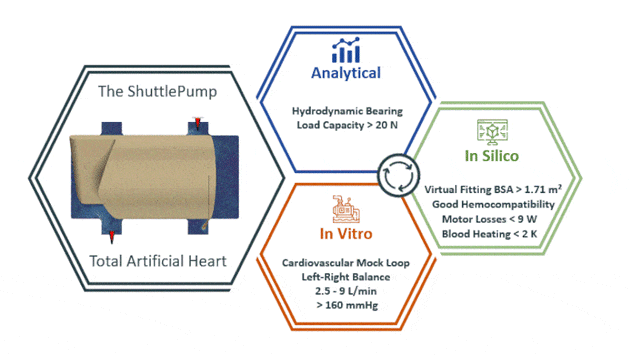This study investigates the feasibility of a novel pumping principle for a valveless pulsatile total artificial heart (TAH) – the ShuttlePump. The proposed concept may overcome the disadvantages of current positive displacement pump concepts through low complexity and small size. At the same time, it may have an advantage over rotary blood pumps due to its lower shear rate profile. The ShuttlePump utilizes a single moving part – a rotating and linearly shuttling piston – housed in a cylindrical chamber with two in-/outlets. The periodic volume change caused by the shuttling, in combination with the opening and closing of the in-/outlets due to the rotational motion, provides pulsatile flow to both the systemic and pulmonary circulation.
An iterative design process, guided by analytical and in silico methods, was utilized to develop the pump and its actuation system. Computational fluid dynamics (CFD) and finite element method (FEM) have been instrumental in the design process. Experimental evaluations in a mock circulation loop simulating the cardiovascular system verified the ShuttlePump’s hydraulic performance over the entire required operating range for a TAH (2.5-9L/min at 50-160mmHg arterial pressure) at stroke rates of 1.5-5Hz. Additionally, left and right atrial pressures were effectively balanced.
The FEM analysis on the actuation system showed a mean total copper loss of 8.84 W, while the CFD results on the maximum local blood temperature rise corresponding to the losses remained below 2K. Additionally, the numerically predicted normalized index of hemolysis was 3.57mg/100L, with 95% of the pump’s blood volume exchanged after 1.42s. The results underscore the feasibility of the novel pumping principle for TAH system. This study provides a solid foundation for further developing the ShuttlePump as a promising solution for the long-term durable cardiac replacement for severe biventricular heart failure patients.

